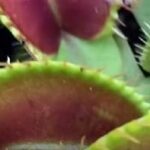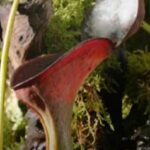As an Amazon Associate, this site earns commissions from qualifying purchases. For more details, click here.
There are few things more alarming for a new pitcher plant owner than seeing its leaves slowly or suddenly turn black. Is this a cause for concern or something totally natural? There are many reasons why its leaves can change color, so in this article you will learn what these are and what you should do about it.
Pitcher plant leaves can turn black when it goes dormant or does get enough light. Lack of water, low humidity, environment change and high temperature can also cause nepenthes leaves to blacken and wither.
Why Pitchers on Pitcher Plants Turn Black
If the leaves on your pitcher plant start turning black, do not panic. As you will see, there are many possible reasons and in most cases it is just natural. The following are the most common situations that cause leaves and pitchers to turn black and how to deal with them. These are applicable to nepenthes and sarracenia species.
Change in Environment
If you just bought a pitcher plant and its leaves blacken, the plant could be adjusting to their new environment. That plant spent most of its life in a store and is suddenly transplanted to a different home. The temperature, humidity, light, the amount of water it gets etc. All are different now and the plant has to adjust. it is only natural for some leaves to die.
Give your plant time to get used to its new surroundings. If you only see a few black leaves here and there, it is nothing to worry about. Keep the plant in its container for the first few days so it gets acclimatized to your surroundings. Make sure you provide enough light, water and food for the plant and it should get accustomed to its new home in time.
When your nepenthes gets used to its new location, those dead, black leaves will be replaced by healthy new ones. If several weeks have passed and new leaves have not appeared, check the other possible causes below.
Not Enough Light
Pitcher plants need 6-8 hours of light to live. Nepenthes pitcher plants prefer hot, humid weather with partial and full light. Sarracenia thrives in full direct light.
You can tell by the color how much light pitcher plants are getting. The leaves become vibrant when exposed to full light and turn pale when it is insufficient. Under certain conditions the leaves will turn black as well. Light plays a vital role in plant life, so make sure your nepenthes or sarracenia get enough of it.
Whether your plant is indoors or outdoors, look for the sunniest spot. Leave the plant there and you will see what difference it makes. You can also use grow lights for indoor cultivation. We recommend the iPower Dual LED Grow Lights because plants respond well to it.
Shedding Old Leaves
So it is normal for pitcher plants to shed leaves during dormancy. But what about those times when leaves turn brown in the middle of spring or summer?
Pitcher plant leaves have a limited lifespan. These pitchers can last 1-8 months, after which the leaves turn brown, black and die. After some time, new leaves and pitchers will grow and take their place.
Pitcher plants can live for a long time with proper care. However, its leaves naturally fall off, die and replaced by new ones. The important thing is to make sure that the dead leaves are replaced. If that is the case you can rest easy.
Not Enough Water
Pitcher plants need plenty of water. Their pitchers actually container water (which you can drink from in certain conditions) along with other liquids used to trap bugs. Without liquids, the leaves dry up and wither.
Pitcher plants are often watered from the top, and some (not all) species may do fine with the tray method. If you are going to use the tray method, use only an inch of water, maybe two inches if it is really hot. Too much could precipitate root rot. You can increase the water level if it is hot and dry, however.
You can also water pitcher plants from the top just like a regular houseplant. All you need to do is water the leaves until the fluid flows down into the roots and out of the plant. Do not use tap water. Rainwater, distilled, filtered and reverse osmosis water are the best choices. Our recommendation is Poland Spring Water for its freshness and cleanliness.
Dormancy
Nepenthes are tropical plants and do not require dormancy. But they do discard leaves as winter approaches. Some of these leaves turn brown or black before falling off. This is normal and nothing to be concerned about. New leaves will replace them in spring.
Sarracenia pitcher plants go through dormancy in the winter and lasts for 3 to 5 months. During this period, its leaves turn black and fall off. Again this is a part of the plant life cycle and not a cause for alarm. Almost all sarracenia goes dormant so this is to be expected.
Lack of Humidity
Pitcher plants require a minimum 30% humidity. Some species require levels of 50% or higher, and it it drops too low the leaves dry up.
Humidity is essential for pitcher plants to thrive. You can water the plant frequently or use a humidifier to keep the level up. You may also place the plant in a greenhouse or terrarium to have better control of the humidity.
However you also need to keep an eye for fungus, bacteria and other organisms that thrive in high humidity. These can be a real problem in terrariums so make sure there is sufficient airflow.
Lack of Food
There are a few things to keep in mind. First if you have outdoor hanging pitcher plants, do not give it any food. Its nectar is enough to attract bugs on its own. Check the pitchers regularly and you should see remains of half eaten bugs. You should only feed outdoor pitcher plants if for some reason they are unable to feed on insects.
Pitcher plants can survive without eating insects, but they will be vulnerable to disease. insects provide nutrients for the leaves so without it the pitchers will turn brown and black. If your pitcher plants are getting enough light and water and its leaves are still black, this could be the reason.
If your nepenthes is outdoors, food should not be a problem. If its pitchers are empty, either the plant is sick or there are no insects in the area. Relocate the plant to somewhere it can prey on more bugs. If your pitcher plant is indoors, feed it 1-4 times a month.
There are many options available and we suggest Omega One Freeze Dried Bloodworms because it is highly nutritious and is the perfect altrnative to live insects.
Extreme Temperature
Temperature, humidity and light are linked to each other, so you have to do a balancing act here. The easiest way is to check the specifications that came with the plant. The package includes information about the temperature, humidity, lighting etc.that is best suited for the plant.
Most pitcher plants thrive in 60-85 F (15-30 C). If the temperature drops too low, the plant will freeze, and if it is too high the leaves dry up.
In general, nepenthes leaves start to dry when the temperature reaches 90 degrees. Some sarracenia variants can handle up to 100 degrees (38 C). It really comes down to the species and how much humidity is present. The best option is to keep the plant in the ideal temperature range.
Pitcher plants will not immediately turn black when the temperature starts rising. The leaves will only start to dry and burn when the temperature stays at 90-100 degrees for a prolonged period.
Incorrect Soil Used
Pitcher plants are sensitive to the soil used. To be on the safe side, use only nutrition free material like peat moss and perlite. Mix these equally and keep it moist. You can also use silica sand and long sphagnum moss.
Use the same type of soil that came with your plant if you are going to repot. Never use fertilizer because it will kill the plant. Let your pitcher plant get its nutrients from bugs. All you need to do is keep the soil damp and the leaves will be fine.
Conclusion
You can also prevent pitcher plants from turning black by not touching the leaves. Do not play with the leaves and do not use rich soil. With regular feeding, light and water, you do not have to worry about black leaves if and when they appear.

My fascination with carnivorous plants began many, many years ago with Venus Fly Traps. Now I am more than happy to impart what I know with other enthusiasts and those who are curious about meat eating plants.



